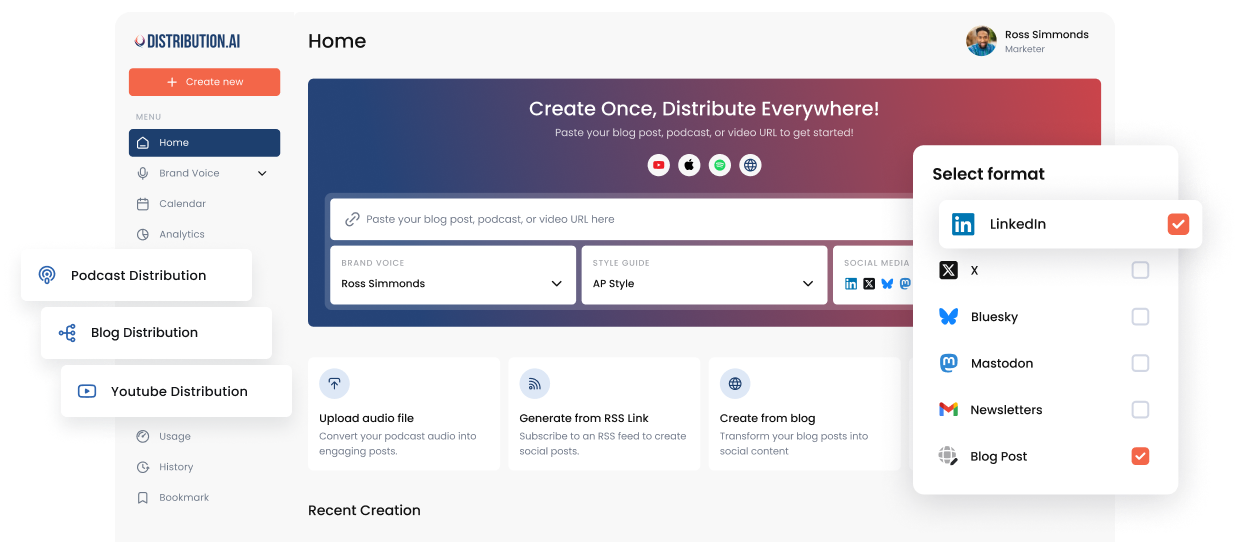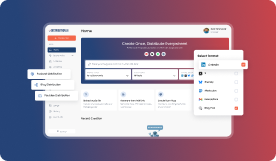Instagram Algorithm: How to Make It Work for You [With Actionable Tips & Strategies]
Learn how the Instagram algorithm works, why some posts rank higher, and how to reset it. Find actionable insights + creator tips for better visibility inside.
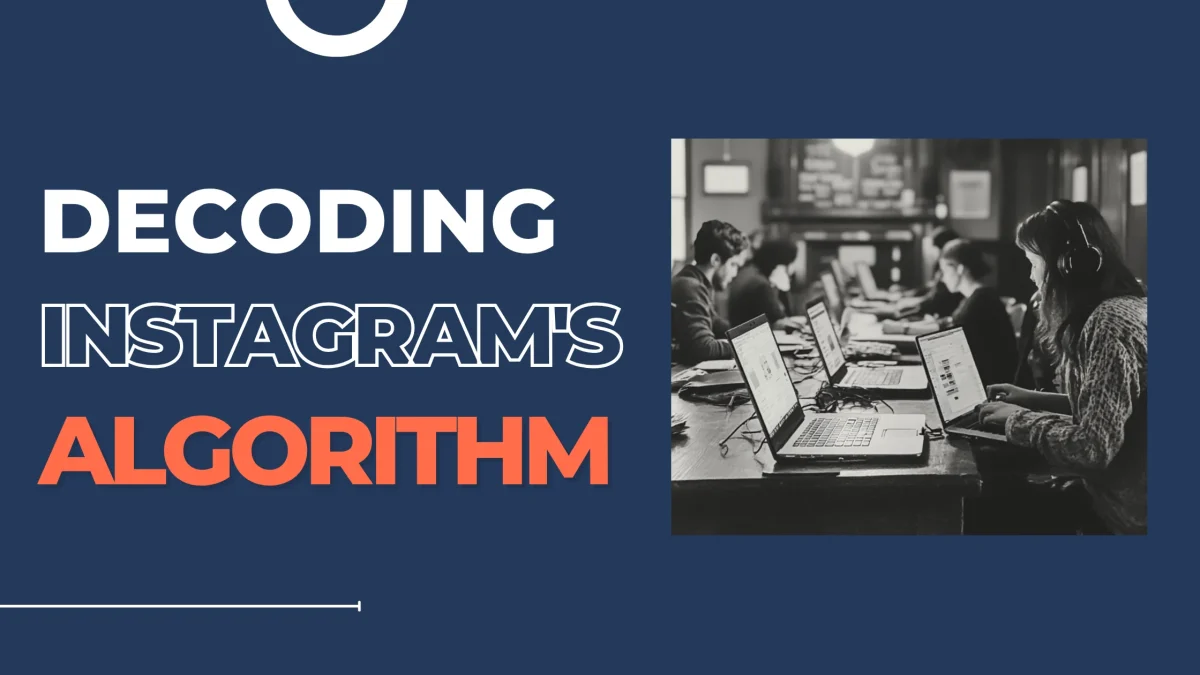
Let’s be real. Every creator and business has faced Instagram reach issues at some point-posts tank suddenly, engagement nosedives, and nothing seems to work.
You post consistently, use relevant hashtags, and your posts still end up buried under less engaging content. That’s because Instagram’s algorithm is constantly evolving to match how Instagram users behave. Whether it’s the feed algorithm, the reels feed, or the explore page, each surface works differently and adapts fast.
In this guide, we’ll break down how the Instagram algorithm works, why it changes so often, and actionable strategies (including insights from real creators) to help you stay ahead.
What Is the Instagram Algorithm & Why Does It Change So Often?
The Instagram algorithm is a set of machine learning systems that decide which posts, reels, and stories appear in a user’s feed and in what order.
Instead of showing content chronologically, Instagram uses a ranking model that predicts what each person will likely engage with next. The algorithm tailors every feed, explore page, and reels tab differently for every user. So, what you see depends on your previous likes, comments, shares, saves, DMs (Direct Messages), and the person who posted it.
Why does the algorithm keep changing?
Instagram’s goal is to keep users engaged for a longer time. But how people use the platform keeps evolving. Hence, the Instagram algorithm changes to adapt.
Here’s a quick look at the three reasons why the algorithm keeps changing:
Evolving user behavior
When users change how they consume content, Instagram’s systems adjust the weight of ranking factors.
For example, in 2024, internal updates and creator reports showed that users were spending significantly more time watching Reels than scrolling static feed posts. As a result, Instagram increased the influence of watch time, saves, and shares—signals that measure depth of user engagement rather than simple likes.
Pro tip: Instead of chasing trends, track what your audience is spending time on. If your analytics show that people rewatch clips or save carousel posts, double down there.
Shifting business priorities
Instagram’s ranking systems are built to serve its business goals — keeping users on the app, improving ad performance, and competing with other social media platforms.
When TikTok’s growth surged, Instagram responded by fine-tuning the reels feed to surface short-form videos with higher completion rates and original audio. It also started rewarding engaging content that builds community. As a result, creators who produce authentic, niche-specific Reels often get better visibility than large accounts reposting generic trends.
Platform quality control and spam prevention
Every few months, Instagram algorithms are updated to penalize spam, engagement pods, and misleading or AI-generated content. When spam spikes, you’ll notice temporary reach fluctuations, which means the system is rebalancing. The algorithm downranks duplicates, excessive keyword stuffing, or posts that violate community guidelines.
How the Instagram Algorithm Works?
The Instagram algorithm is designed to predict what users want to see next across the feed, stories, reels, and explore page. It studies how people interact with posts, scores those interactions, and constantly reshuffles visibility to maximize engagement and retention.
Each surface (Feed, Reels, Explore, Stories) has its own algorithm with unique ranking factors, though the core idea stays the same—personalization and prediction.
Feed algorithm
The Instagram feed algorithm focuses on relevance and relationships (interaction between accounts). It decides what appears first based on what you’ve liked, saved, shared, or discussed recently.
Factors considered:
- Your activity: The accounts you engage with, posts you like or comment on, and the time you spend on them.
- Post information: Content format (photo, carousel, video), caption text, hashtags, location tags, and recency.
- Information about the person who posted: Frequency of interactions (comments, profile visits, DMs).
- Engagement type: Saves and shares are stronger than likes; they signal lasting interest.
How it plays out:
When you publish, Instagram shows the post to a small group of engaged followers first. If they respond quickly, especially with saves or shares, your post appears higher in followers’ feeds and even in “Suggested for You.” That means, the more the interaction, the higher the post reach.
Reels algorithm
The Instagram reels algorithm is built to find content that stops users mid-scroll and keeps them watching till the end.
Factors considered:
- Watch time and completion rate: The stronger the retention, the higher the ranking.
- Replays: If viewers replay the same clip, that’s a powerful engagement signa
- Shares and sends: Reels forwarded via DMs or shared to Stories score higher.
- Originality: Authentic or remixed videos outperform direct reposts or low-resolution content.
- Audio track relevance: Using trending music can help, but overused audio tracks reduce uniqueness.
How it plays out:
Reels first reach a mix of followers and users with similar interests. When watch time and shares exceed a threshold, the Reel moves to the reels feed and explore page. Recycled TikToks or watermark-heavy clips get downranked.
Explore Page algorithm
The Instagram explore page is where people discover new creators. It prioritizes content that performs well with users outside your follower base.
Factors considered:
- Engagement from non-followers: Posts that gain saves, shares, or comments beyond your audience signal wide appeal.
- Content similarity: How closely your post aligns with topics similar users have engaged with.
- Post quality & originality: Crisp visuals, educational carousels, or snackable tips often perform best.
- Hashtags & metadata: Relevant hashtags and location tags strengthen topical mapping
How it plays out:
When a post enters the Explore page, Instagram first tests it with a small “look-alike” audience—users who behave similarly to those who already engaged with the content (same interests, hashtags, or engagement patterns). If this group watches, saves, or shares the post, it is shown to larger clusters of similar users. But if engagement or dwell time drops even slightly, the algorithm quickly replaces it with newer, higher-performing content.
Stories algorithm
The Instagram stories algorithm is relationship-first. It decides whose stories appear at the front based on how close you are to them digitally.
Factors considered:
- Frequency of interaction: Who you message, react to, or tag most. If you interact with a creator’s post frequently, their stories show up first
- Story engagement: Poll votes, replies, quiz taps, or emoji reactions
- Consistency: Accounts that post Stories daily rank higher than those that post infrequently
- Response rate: Creators who reply quickly to Story DMs maintain stronger connection scores
How it plays out:
Stories don’t usually drive discovery, but they reinforce feed and reels reach. Engaging Stories (polls, quick Q&As) refresh relationship signals and make your posts appear higher elsewhere, such as the feed and Reels tab.
Why Do Some Posts Get More Visibility Than Others?
Once you understand how the Instagram algorithm works, the next question is: Why do certain posts outperform others, and what can you do about it?
The answer lies in what triggers stronger engagement signals and what keeps users watching or interacting longer.
Here are five reasons why some posts have higher visibility than others, and some actionable tips for your Instagram content visibility.
The first hour reach
The Instagram algorithm uses your early engagement as a “quality check.” If your audience interacts (likes, comments, saves, or shares) soon after posting, Instagram expands distribution.
We found a Threads post that mentioned Hootsuite’s early engagement experiment. The test revealed that Instagram posts with high engagement in the first hour saw nearly 3x more reach, and the engagement rate in the first hour was 4.5x higher.
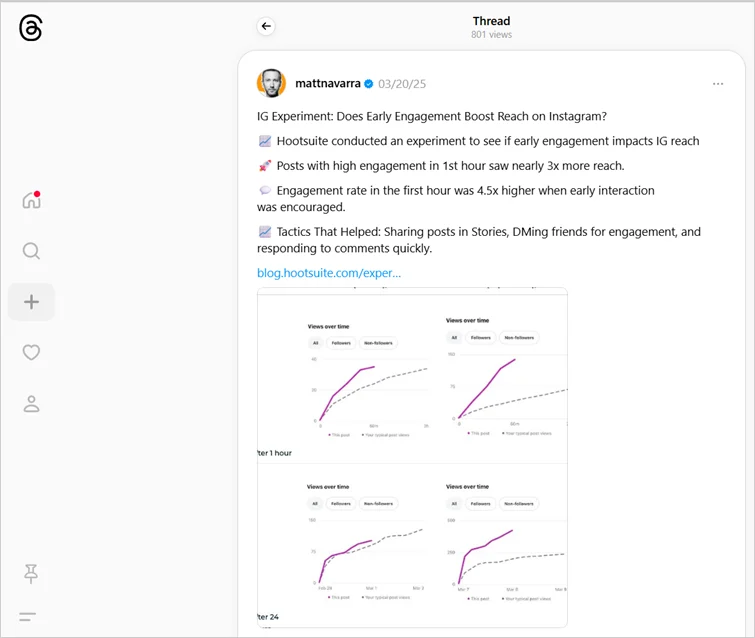
What you can do:
- Find the best times to post on Instagram so your post is live when your target audience is most active
- Use Instagram captions that encourage quick action. For example, “Tag someone who needs this” or “Save this for later.”
Creative tools like Distribution AI can help you repurpose content to create fresh posts with captions that grab your target audience’s attention. Sign up for a free trial!
Higher saves and shares
Saves and shares are strong signals. They tell Instagram that your post delivers lasting value and that it’s worth revisiting or recommending.
According to Meta’s Guidelines that apply to Facebook and Instagram, saves, shares, and time spent indicate deeper engagement, and are often used to determine which content appears in a user’s Feed and Explore tabs.
What you can do:
- Create carousels or checklists people want to reference again.
- Add small prompts like “🔖 Save this post to apply later.”
Relevance over variety
Switching topics or content styles too often can confuse the algorithm. If you’ve built traction with marketing tips but suddenly post travel vlogs, your existing audience’s engagement drops, and so does reach.
What you can do:
- Stick to 2–3 consistent content themes.
- Use different content formats (carousel, Reel, Story), but stay predictable in topic. It helps the algorithm match your posts to the right interest clusters.
💡Pro Tip: If you think you’re running out of content ideas with your interest clusters, try content repurposing. Tools like Distribution AI automatically generate multiple posts tailored to Instagram from your existing content assets like blogs, podcasts, and videos. This saves you hours of brainstorming and ensures you maintain consistency with publish-ready posts.
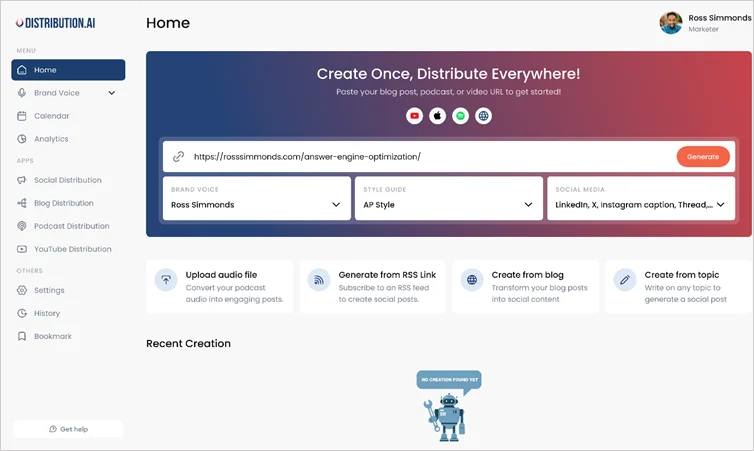
Retention drives Reels’ visibility
For Instagram reels, the single biggest visibility factor is watch time, that is, how long people stay before swiping away. The algorithm tracks how many viewers finish watching, replay, or share your video, then compares those numbers to similar posts published around the same time. Reels that hold attention longer than average get pushed to the reels feed and explore page faster.
What you can do:
- Grab attention in the first 3 seconds with captions, movement, or questions.
- Cut unnecessary intros — start with payoff or intrigue (“Here’s the mistake that cost me $10k”).
- Add on-screen text for silent viewers—60% of Reels are watched without sound.
Original content over reposts
According to Instagram’s updates, the platform now actively boosts original content and suppresses low-quality reposts or watermarked clips. It highlights original videos and reels in recommendations by replacing reposts with originals.

What you can do:
- Post directly inside Instagram instead of cross-posting from TikTok.
- If repurposing, re-edit videos—change text overlays, aspect ratio, and add native captions.
- Keep visuals crisp; low-resolution or heavy filters reduce ranking potential.
Repurposing the same content for different social platforms can take hours (even days). And that’s exactly why you need tools like Distribution AI that repurpose content tailored to specific social media platforms.
It ensures writing the post in your brand’s voice to maintain consistency, plus you can schedule posts for publishing at the best times and track their performance.
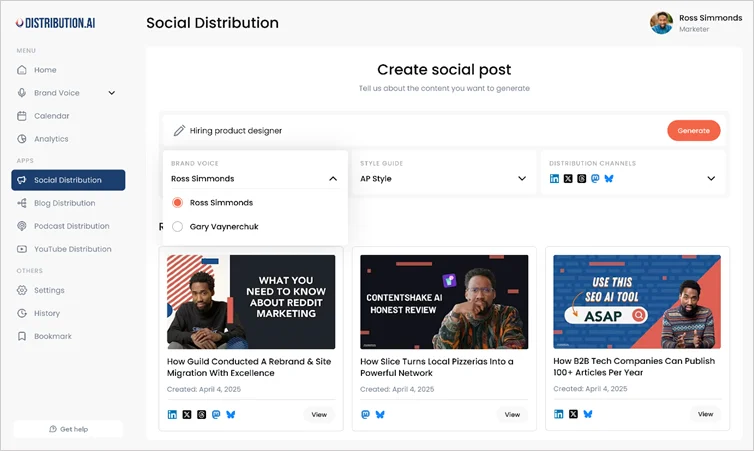
How to Reset the Instagram Algorithm?
Now you know why some posts get more visibility than others.
But what if your reach drops without explanation, despite posting consistently and maintaining quality?
That usually means the algorithm’s “understanding” of your Instagram account is outdated.
Instagram’s system constantly learns from your content, engagement history, and audience behavior. If you pivot niches, interact with unrelated posts, or go inactive for long stretches, your signals drop, and so does reach.
The fix is retraining the algorithm to recognize your content correctly again.
Audit and clean your engagement footprint
Creators often underestimate how much their own activity influences their reach. Every like, follow, and save teaches Instagram who you are and what topics your content belongs to.
So if your feed is full of random memes or non-niche trends, your account signals get messy.
Here’s what you can do:
- Unfollow irrelevant accounts or mute them for 30 days.
- Tap “Not Interested” on unrelated Explore or Reels content.
- Stop engaging with posts outside your target niche for at least a week.
This process refines the behavioral data that shapes how your future posts are categorized.
Rebuild your signals within your niche
Spend 10–15 minutes daily interacting with your ideal audience content or competitor accounts — comment, save, or reply meaningfully. This rebuilds your interaction history and strengthens topic association.
On Reddit, several creators and brands shared that interacting with your ideal audience’s content can help you rebuild signals.
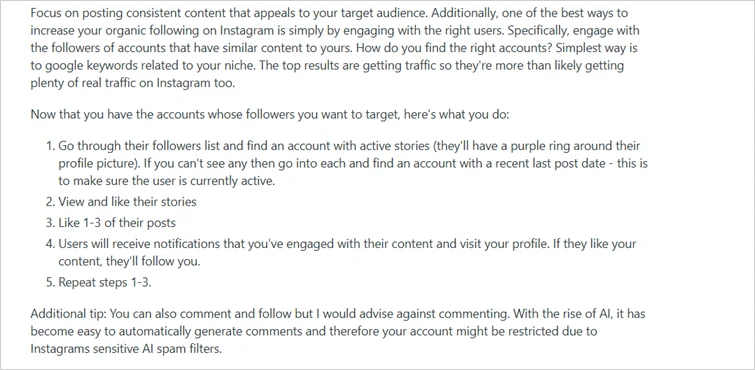
Publish fresh, niche-aligned content immediately after cleanup
Once your engagement signals are focused, post new content that clearly fits your niche.
Use relevant hashtags, consistent tone, and formats your target audience interacts with most (e.g., Reels for tutorials, carousels for frameworks).
The first 5–10 posts after your behavioral reset are crucial. They help Instagram relearn what your account stands for. However, expect lower reach initially. Once you consistently post, you rebuild the model’s trust in your content’s relevance.
Watch for recovery metrics in Instagram Insights
Use Instagram Insights to check whether your reset is working. Track the following metrics:
- Non-follower reach: Higher non-follower reach means your posts are surfacing to new audiences.
- Saves and shares: The more saves and shares, the stronger content quality signals.
- Profile visits: More profile visits mean improved content-audience match.
If you want more detailed analytics, consider tools like Distribution AI. Using Distribution AI, you can track engagement rate, click-through rate, top-performing content, and more social media KPIs and metrics.

5 Tips to Work with the Instagram Algorithm
Here are a few tips to help you flow with Instagram’s algorithm so your content gets higher visibility and reach.
- Leverage the first-15-minute window: Post your Instagram content in the 7 am to 4 pm window and then spend 10 minutes immediately after posting engaging (replying to comments, viewing stories) to boost early signals.
- Use story replies: After posting a major piece, follow up with a Story referencing it—ask a question or poll (“Which tip did you try?”). Use replies to spark lateral engagement, lifting your interaction signals.
- Implement scheduling tools: Use social media scheduling tools or batch-create Story templates so your account stays active daily, even on low-content days. A simple “poll,” “behind-the-scenes clip,” or “repost of user content” maintains your connection score.
- Don’t chase every trend: Monitor trends with social listening tools, track what your audience talks about, and post on those topics to ensure content relevance.
- Use niche-relevant audio: Search for audio that’s growing (not yet viral) in your niche. For example, a rising business podcast snippet or an industry-specific meme. Combine it with your brand’s tone or caption overlay to stand out without blending in.
Start Making the Instagram Algorithm Work for You
The Instagram algorithm is a dynamic system built to surface what keeps people engaged. Once you understand its ranking factors, it becomes a creative advantage.
Keep your Instagram strategy focused with consistent themes, engaging content, and formats that match how people consume Instagram feed posts and Instagram reels. Use data to reveal what’s working and what’s not across feed and stories. And if managing all this feels overwhelming, tools like Distribution AI can help.
With Distribution AI, you can schedule Instagram posts, repurpose long-form content into platform-ready posts and creatives, and track engagement across social media platforms, maintaining a consistent brand voice.
Frequently Asked Questions
Promote, repurpose & distribute your content with AI
Start 15-Day Free Trial